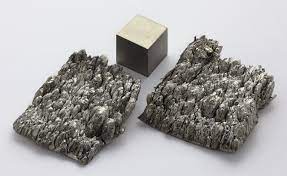Identity.
itanium (Ti), chemical element, a silvery gray metal of Group 4 (IVb)
of the periodic table. Titanium is a lightweight, high-strength,
low-corrosion structural metal and is used in alloy form for parts in
high-speed aircraft.
Atomic Structure:
Titanium Atomic Number and Electronic Configuration Ar-Ar 3d2 4s2. It
has 2 electrons in K – shell, 8 electrons in L – shell, 10 electrons
in M – shell, and 2 electrons in its outermost shell N.
History.
The story of titanium starts in the late 18th century, not with a
scientist, but with a clergyman! In 1791, William Gregor, an amateur
geologist in England, stumbled upon an unknown element while studying
black sand. He named it "menachanite," unaware of the hidden treasure
he held. It wasn't until almost a century later, in 1887, that German
chemist Martin Heinrich Klaproth identified and named the pure element
"titanium" after the mythological Titans known for their strength.
Isolating titanium, however, proved even more challenging. Early
attempts resulted in brittle, impure forms. It wasn't until the 1930s
and the development of the Kroll process that scientists could finally
produce usable metallic titanium. This breakthrough paved the way for
its modern applications.
Titanium's properties quickly turned heads. Despite being lighter
than steel, it boasts remarkable strength and corrosion
resistance. This unique combination made it perfect for the
aerospace industry, where weight reduction is crucial. From jet
engines to airframes, titanium became a key player in aircraft
design.
But its applications extend far beyond the skies. In medicine,
titanium's biocompatibility makes it ideal for prosthetics and
implants, offering durability and integration with the human body.
In everyday life, you might find titanium in sports equipment,
bicycles, and even jewelry, valued for its strength, lightness,
and aesthetic appeal.
As research continues, the potential of titanium keeps expanding.
From exploring its use in energy storage to delving into its
properties at extreme temperatures, this versatile element
continues to surprise and inspire scientists and engineers around
the world.
Usage.
Scandium is mainly used for research purposes. It has, however, great
potential because it has almost as low a density as aluminium and a
much higher melting point. An aluminium-scandium alloy has been used
in Russian MIG fighter planes, high-end bicycle frames and baseball
bats.
Scandium is used in aluminum-scandium alloys for aerospace industry
components and for sports equipment such as bicycle frames, fishing
rods, golf iron shafts and baseball bats. Scandium iodide is used in
mercury vapor lamps, which are used to replicate sunlight in studios
for the film and television industry.
Some of the benefits of using scandium are:
-
Scandium-aluminum alloys can help make airplanes lighter, which
improves fuel efficiency and range.
-
Scandium alloys could lead to longer-lasting and more powerful
batteries for electric vehicles and other devices.
-
Scandium-based materials could improve the efficiency and
durability of fuel cells, which are a clean and sustainable energy
source.
Sources.
Scandium, a silver-white metallic element, might be rare, but it pops
up in surprising places! It's found in trace amounts in many minerals,
but commercially, it's usually extracted as a byproduct from mining
other metals like titanium and uranium. While Madagascar and
Scandinavia boast rare minerals with concentrated scandium,
thortveitite being the champion, most comes from reprocessing waste
materials from other mining operations.
Properties.
Scandium, a silvery-white metal, boasts several unique properties that
set it apart. It's remarkably lightweight, yet exceptionally strong,
making it an attractive candidate for high-performance alloys used in
airplanes and even baseball bats. Scandium also readily conducts
electricity and heat, making it useful in some types of lighting and
potential future applications like fuel cells. But perhaps its most
interesting property is its rarity. Despite being the 23rd most
abundant element in Earth's crust, it's scattered in trace amounts,
making its extraction a fascinating scientific and engineering
challenge.

